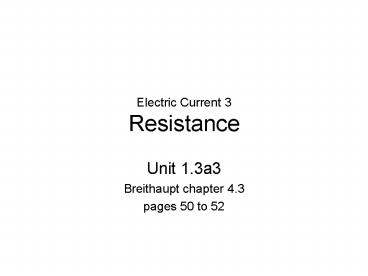Electric Current 3 Resistance - PowerPoint PPT Presentation
1 / 15
Title:
Electric Current 3 Resistance
Description:
Measure the current through the resistor with the ammeter. ... high as possible so that the ammeter only measures the current through the resistor. ... – PowerPoint PPT presentation
Number of Views:414
Avg rating:5.0/5.0
Title: Electric Current 3 Resistance
1
Electric Current 3Resistance
- Unit 1.3a3
- Breithaupt chapter 4.3
- pages 50 to 52
2
AS specification
- Resistance is defined by R V / I
- Ohms law.
- ? RA / L
- Superconductivity as a property of certain
materials which have zero resistivity at and
below a critical temperature which depends on the
material. Applications (e.g. very strong
electromagnets, power cables). - Breithaupt chapter 4.3 pages 50 to 52
3
Resistance
- resistance p.d. across a component
current through the component - R V / I
- also V I R and I V / R
- resistance in measured in ohms (O)
- potential difference in volts (V)
- electric current in amperes (A)
- Resistance is a measure of the difficulty of
making a current pass through a substance. It is
caused by the repeated collisions between the
charge carriers and the positive ions of the
substance. - Resistance simulation at Phet Resistance
equation demo at Phet
4
Questions
- 1. Calculate the resistance of a device if a
current of 250mA flows when a potential
difference of 6V is applied - R V / I
- 6V / 0.250A
- 24 O
- 2. Calculate the current that flows through a
resistance of 4MO when 60V is applied across it - I V / R
- 60 V / 4 000 000 O
- 0.000 015 A 15 µA
5
Complete
6
Answers
7
Measuring resistance
- Set up the circuit opposite.
- Measure the current through the resistor with the
ammeter. - Measure the potential difference across the
resistor with the voltmeter. - Calculate resistance using R V / I .
- Further sets of values of I and V can be obtained
by changing the setting of the variable resistor.
From these an average value for resistance can be
obtained. - Note The resistance of the voltmeter should be
as high as possible so that the ammeter only
measures the current through the resistor. - Fendt Ohms law simulation
8
Ohms law
- Ohms law states that the potential difference
across an ohmic conductor is proportional to the
current through it, provided the physical
conditions do not change. - A graph of p.d. against current for a conductor
obeying ohms law will be a straight line through
the origin. - The gradient of such a graph is equal to the
resistance of the conductor. - Physical conditions remaining constant include
temperature and the dimensions of the conductor
9
Resistivity (?)
- Experiments show the the resistance of a
conductor is - 1. proportional to its length, L
- 2. inversely proportional to its
cross-section area, A - and so R a L /A
- the constant of proportionality is the
resistivity, ? of the conductor - Therefore R ? L A
- Reisistivity equation demo at Phet
- KT resistivity simulation
10
Variation in resistivity
- Resistivity is measured in ohm-metre, Om.
- Metals (e.g. copper) and other good conductors
have very low resistivities. - Good insulators (e.g. PVC) have very high
resistivities. - Semiconductors (e.g. silicon) have intermediate
resistivities - Resistivity table on Wikipedia
11
Superconductivity
- Superconductivity is a state where certain
materials have zero resistivity. - This occurs at and below a critical temperature
(Tc) which depends on the material. Tc is usually
below 200oC. - Applications include
- very strong electromagnets (e.g. in MRI scanners)
- power cables to prevent wastage of electrical
energy (e.g. to supply the LHC)
12
Questions on resistivity
- 1. Calculate the resistance of a 0.30m length of
copper wire of cross-section area 5 x 10-6 m2
resistivity of copper 1.7 x 10-8 Om - R ? L A
- (1.7 x 10-8 Om) x (0.30m) / (5 x 10-6 mm2)
- 0.00102 O 1.02 mO
- 2. Repeat the above question, this time with
silicon resistivity of silicon 2300 Om - (2300 Om) x (0.30m) / (5 x 10-6 mm2)
- 1.38 x 106 O 138 MO
13
3. Calculate the resistivity of a metal wire of
cross-section diameter 0.4mm if a 25cm length of
this wire has a resistance of 6O.
- A pd2
- 4
- p x (4 x 10-4 m)2 / 4
- p x (1.6 x 10-7 m2) / 4
- cross-section area 1.2566 x 10-7 m2
- ? RA
- L
- (6 O) x (1.2566 x 10 -7 m2 ) / (0.25 m)
- resistivity 3.02 x 10 -6 Om
14
Notes from Breithaupt pages 50 to 52
- What is resistance? Give the equation defining
resistance and a sample resistance calculation. - Draw a circuit diagram and explain how resistance
can be measured. - What is Ohms law? How can Ohms law be verified
graphically? - Give the equation for resistivity. Calculate the
resistance of a copper wire of diameter 1mm and
length 3m. - Compare the resistivities of copper, silicon and
PVC. - What is superconductivity? When does it occur?
Give two applications. - Try the summary questions on page 52
15
Answers to the summary questions































